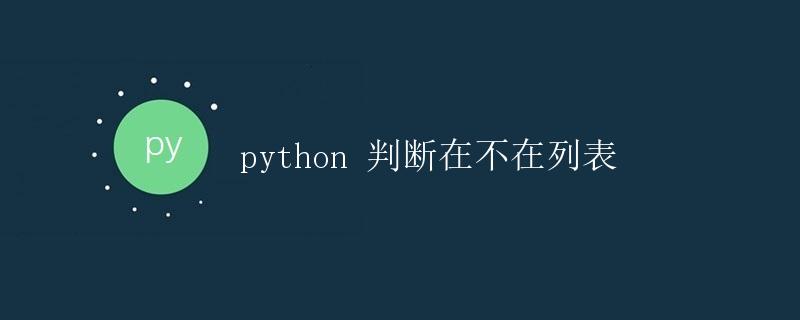Python 判断在不在列表

在编程过程中,经常需要判断一个元素是否在一个列表中。Python提供了几种方法来实现这一目的。在本文中,我们将详细介绍如何使用Python来判断一个元素是否在一个列表中。
使用in关键字
在Python中,可以使用in关键字来判断一个元素是否在一个列表中。语法如下:
element in list
其中,element是要判断的元素,list是要判断的列表。
下面是一个示例:
# 定义一个列表
fruits = ['apple', 'banana', 'cherry', 'orange']
# 判断元素是否在列表中
if 'apple' in fruits:
print('apple is in the list')
if 'pear' not in fruits:
print('pear is not in the list')
运行结果:
apple is in the list
pear is not in the list
使用not in关键字
与in关键字相反,not in关键字用于判断一个元素是否不在一个列表中。语法如下:
element not in list
下面是一个示例:
# 定义一个列表
fruits = ['apple', 'banana', 'cherry', 'orange']
# 判断元素是否不在列表中
if 'apple' not in fruits:
print('apple is not in the list')
if 'pear' not in fruits:
print('pear is not in the list')
运行结果:
pear is not in the list
使用循环遍历列表
除了使用in关键字和not in关键字之外,还可以使用循环遍历列表来判断一个元素是否在列表中。下面是一个示例:
# 定义一个列表
fruits = ['apple', 'banana', 'cherry', 'orange']
# 要查找的元素
element = 'cherry'
# 遍历列表
for fruit in fruits:
if fruit == element:
print(element + ' is in the list')
break
else:
print(element + ' is not in the list')
运行结果:
cherry is in the list
使用index()方法
除了上述方法之外,还可以使用列表的index()方法来判断一个元素是否在列表中。index()方法返回指定元素在列表中第一次出现的位置,如果元素不在列表中,则会抛出ValueError异常。下面是一个示例:
# 定义一个列表
fruits = ['apple', 'banana', 'cherry', 'orange']
# 要查找的元素
element = 'cherry'
try:
index = fruits.index(element)
print(element + ' is in the list at index ' + str(index))
except ValueError:
print(element + ' is not in the list')
运行结果:
cherry is in the list at index 2
使用count()方法
另外,还可以使用列表的count()方法来判断一个元素在列表中出现的次数。如果元素出现的次数大于0,则说明元素在列表中;如果出现的次数等于0,则说明元素不在列表中。下面是一个示例:
# 定义一个列表
fruits = ['apple', 'banana', 'cherry', 'orange']
# 要查找的元素
element = 'cherry'
count = fruits.count(element)
if count > 0:
print(element + ' is in the list')
else:
print(element + ' is not in the list')
运行结果:
cherry is in the list
总结
本文介绍了几种方法来判断一个元素是否在一个列表中,包括使用in关键字、not in关键字、循环遍历列表、index()方法和count()方法。开发者可以根据具体的情况选择适合自己的方法来实现需求。
 极客教程
极客教程